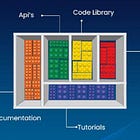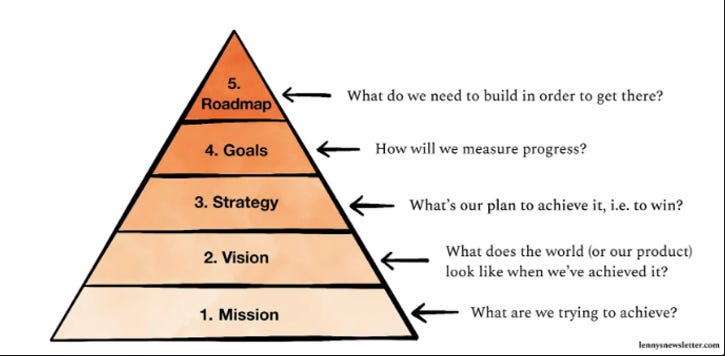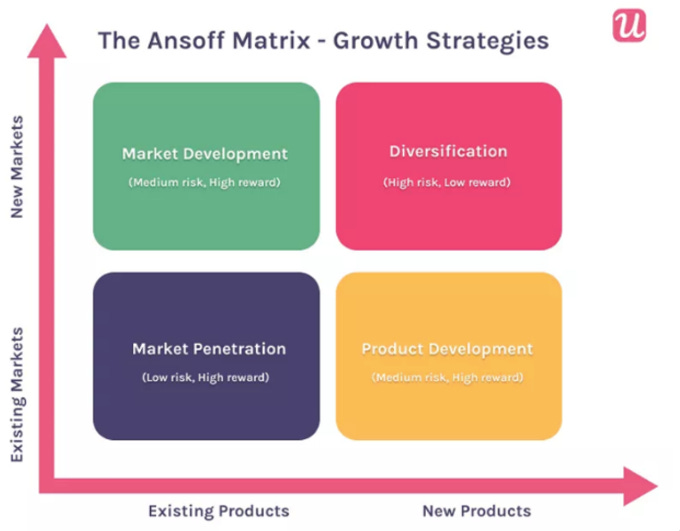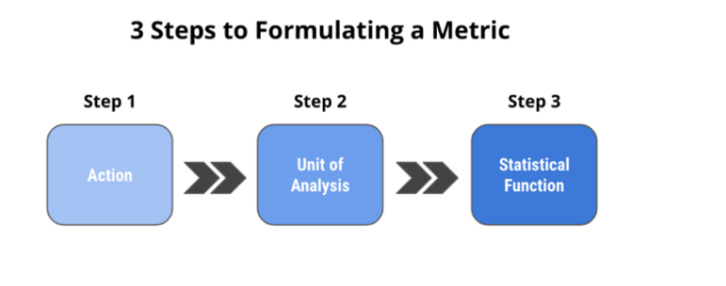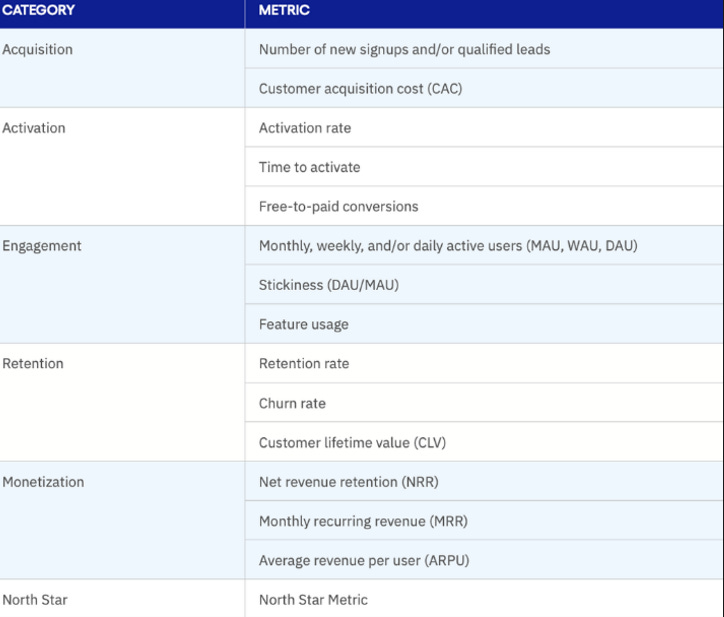A generalization of Product Managing pt3 - From high to low
On PM-ing and company management in general from very high to very low levels of work
Okay so this is already longer than I expected this would be, but I feel like leaving without detailing the work is just unjustified, it makes things even more generic than where I begin.
But still, this blog is not meant for day-to-day work, the small stuff, but rather for a more holistic approach to the job and some hands-on methods that can help you survive.
You can view the other parts of this series here
Disclaimer
This blog will be about the frameworks I’m using, based on several sources, and vary from time to time based on the demand. No size fits all so I hope this helps.
But I do think that a Product Manager needs to have a company-level understanding, if you are good enough you should know how a company is run. You aren’t on the PM level yet if you can't articulate the ideas (Believe me, I know PMs who haven’t even tried the product or can’t understand what the company is doing)
Where to begin
Imagine you are in a new company, freshly hired as a PM or higher level, Senior, Group, Head, VP of product. The one thing you need to understand even before walking in the door is high-level stuff, essentially why this company exists and why you are here.
A good company should have Values, Mission, and Vision every time.
This concept can be tricky so let me quickly explain
Value is the company itself, what it desires and stands for
Then the company creates a Mission, that is out-of-the-world, hard to reach, yet believable.
Then, vision, a company state in 5, 10, or 15 years, should be the checkpoints to reach the mission, even if the mission is impossible, the vision is reachable and can be changed.
For me, the order goes from high to low. Value first, then Mission and Vision. These ideas should inform your Goals and Strategy.
As there are many ways to elaborate, I will take two more examples from Lenny
And Reforge
Different in description and vary in concepts, but one thing remains true, start with Mission and Vision. Those are the kick-off points and everything should align with those.
And yes, sure, and yes again. Understanding a company situation inside out is needed, where your company stands, financial state, resources, tech stack, etc. Consume the information and start questioning everything.
What’s next?
Understand the why of a company to come up with the why, what, and how of the product. This is where the training is finished and the job is yours.
So how exactly do you realize the Vision of a company? For example, if your company wants to be the most profitable SAAS company in logistics in SEA by 2025.
How do you archive this?
Goals and Strategy, are closely related as Goals are where you want to go, breaking down Vision into smaller parts, and Strategy is essentially how you achieve that.
Let’s talk about company goals
A goal is a target, an end that helps you get the Vision, and should be measurable outcomes.
If your vision is to have a memorable vacation in Europe this summer. Then goals can be:
Save enough money for the trip
Get everything ready before summer
Get to Europe safely and on time
Enjoy your time there within the budget
I see some companies manage this using OKRs, well most of the “Modern” companies. While the older ones tend to use KPI.
A KPI, also known as a Key Performance Indicator, is a measurable value that demonstrates how well an organization is achieving its current objective.
An OKR, also known as Objectives and Key Results, is a framework for defining and tracking company, team, or personal objectives.
In modern company management setting these measurable goals system is needed to inform everyone on what needs to be done, this should be the top priority.
The second priority is to track the performance.
If these priorities are upside down in your company, I would consider that company kinda outdated IMO. And these are the major ones right, I understand there are more than 2 ways to do this.
And the product goals
A company is different from the product, and the CEO and CPO can’t be the same person for a very good reason.
This is because the product goals and company goals are different. E.g.
Company X wants to double their ARR this year, okay reasonable
Company X has only one product, Y. So that would mean this product needs to be doubled, right? ⇒ Wrong, Insert Trump meme here this is where things get mixed up badly.
Proper goals can be the following
Increase retention by X% so conversion and increase by Y% so the revenue and increase by Z%
Or exploring a new use case and creating another product so it can share the ARR goals, this new product B can have XX ARR this year.
Or getting insight and changing pricing, offering, tier, whatever so the product makes YY ARR.
Those should be the product goals for 2024-2025 so the company can achieve the company goals in 2025.
That is also a reason why the CPO role exists while you already have a CEO, they have different goals to begin with.
Let’s talk strategy
Again, for me, there are 02 types of strategy. A company strategy and a product strategy, where is first one informs the latter similarly to goals.
Creating a company strategy is harder than creating a Mission and Vision. Any day any guy can dream about a company and what he would do to change the world, but executing is king here, as not everyone can do it.
An example of a company strategy and product strategy from Clubhouse, dang, this used to be hot a while back, come with a solid strategy.
Mission - Authentic conversion and expression
The clubhouse was designed to be a space for authentic conversation and expression—where people can have fun, learn, make meaningful connections, and share rich experiences with others around the world.
Company Strategy - Create a new market for a voice-based social network
The clubhouse is a new type of social network based on voice—where people around the world come together to talk, listen and learn from each other in real time.
Product Strategy - Make access easy for everyone who joined but make joining the product exclusive (Limit access in the early day)
When you open the app you can see “rooms” full of people talking—all open so you can hop in and out, exploring different conversations. You enter each room as an audience member, but if you want to talk you just raise your hand, and the speakers can choose to invite you up. Or you can create a room of your own. It’s a place to meet with friends and with new people around the world—to tell stories, ask questions, debate, learn, and have impromptu conversations on thousands of different topics.
This a pretty good insight into how they choose the voice to foster authentic conversations
"Clubhouse is voice-only, and we think voice is a very special medium. With no camera on, you don’t have to worry about eye contact, what you’re wearing, or where you are."
When you have a good enough strategy, the execution is way easier and the the rest is history.
What strategy is NOT, and how to detect a good one
Strategy is NOT
Goal or metric - These are to remind us where we are going and also track progress
Roadmaps - Roadmap is a list of items on a timeline, not a strategy yet
Feature or Product - Nope, these are one of the ways to do things, not everything
Budget - You are not a project manager
Mission - This is way bigger than strategy dude, this is the way, strategy is how
So what a strategy is
This video sums up very well what a strategy is
A set of choices that positions you on a playing field of your choice in a way that you win
So good strategy should have
Coherent and visible → Everyone gets it and gets it similarly
Doable → Translate into action, strategy isn’t a plan but needs a plan
Short and understandable → Easy to implement and transfer
Targeted → Focus on a limited number of things, segments, markets, goals…
More than often I see bad strategy, you can smell the confusion, the excessive meetings to explain things or sync ideas, repeated questions that have no proper answers, and people doing multiple things because they want visibility but can’t explain why. Yada yada.
One more thing before wrapping up the strategy, it usually falls into one of these 4 categories, if anything is different from those, happy to learn more.
Screenshot from UserPilot
Let’s talk about the Roadmap (Finally)
As you might see, getting to Roadmap is quite a ride, more than often I heard PMs work on Roadmap in their first 30 days, I mean for real? You don’t have enough knowledge for that unless you get a roadmap from your previous company and put it here.
And would like to repeat it again
A roadmap is a list of items on a timeline
There are several ways you can come up with one:
Already existing product - Feature audit - The product team reviews the usage levels of its product features and plots them on a graph. The graph charts two data points:
The percentage of customers who use each feature (the x-axis)
How often users access those features (the y-axis)
After the audit, you should have some options to do the following: Improve, Observe, Kill features, essentially some months to improve an existing product
Contextual interview and look for data
Good old meet-and-talk-to-user
Gather the data from the interview and on the market
Formulate insight and create a hypothesis
Test the hypothesis (Might not need coding yet)
Items on the roadmap for validated ideas (or sometimes build some time to validate, not recommend though)
You can do the same for existing products, basically understanding the current state and new insights will help you create the expected state → roadmap is just how to get there
Job to be done (JTBD)
An interview should be done previously to understand the context, product, etc first
Get a team, have a collecting plan, and understand the outcome that your user needed
Create a JTBD and Job map with all the steps within.
Map each step with one outcome, and interview and survey people to get those
The item is ready to be split into Job stories to do
These are just ways, right, not everything, and can be used with each other, no framework is better in every case so I would recommend finding your best. I would likely use all three and several other frameworks during my PM day.
Prioritization for a company, a product Roadmap, and a smaller timeframe
So now let’s assume you have every item that you want to make, but do you know any god that creates products? I don’t. So you working with Mortal now, and they can’t work 24/7. Time to prioritize things with some principles:
Prioritize things that most people (user not stakeholder, okay sometimes stakeholder just between you and me alright) want (Log in…) or impacted (Can’t log in...)
Prioritize things that cost less (time, and money…)
Prioritize things that need to or can be done first (Backend or Infrastructure usually can be done before Frontend for example)
And lastly, and most importantly, prioritize things that are dead or alive to your company ranging from months-worth-deal for a new company that is struggling or regulations that need to be done now or you go to jail.
There you have it, some framework that might help you with this:
Gap analysis - Know how far you are behind the market, and prioritize the most basics.
Kano - Priority is the most essential to satisfy user
Moscow - Priority must be based on functionality - performance - delighter
For me, MoSCow is the easiest to use, and good when applied with the User story mapping framework.
Metrics
One of the hardest things in Product management is the METRICS. In this, I will only focus on the Product metrics, as a PM you should know the company and SAAS business metrics in general but that would be a different topic.
This would also rule out what I would think more on company-wide metrics like Northstar metric.
The product metrics should be figured out before you want to do the feature and after you get hypothesized. It’s the thing that helps you answer the hypothesis.
There are several ways to formulate a metric, I would normally use the 3 steps model
Identify an action to measure:
Count (e.g. clicks, page views, visits, downloads)
Time (e.g. minutes per session)
Value (e.g. revenue, units purchased, ads clicked)
2. Chose the unit of analysis:
Per session (e.g. minutes per session)
Per-user (e.g. clicks per user)
Per page (e.g. revenue per page)
Per time (e.g. views per month)
3. Choose a statistical function
Average (e.g. average minutes per session)
Total (e.g. total revenue per month)
Count (e.g. click count per week)
Median (e.g. median revenue per user)
With this, you can formulate every metric without frameworks, but please understand why you create something, what you do not know yet, and how to answer that.
Taken to the Clubhouse example above, you know the ideas and want to measure success. Some metrics can be formulated from there e.g.
Success definition: Make access easy for everyone who joined but make joining the product exclusive (Limit access in the early day)
What is easy access?
A short time from login until receiving the value
Interval time between receiving that value point
What is value?
Users got meaningful conversation - Meaning they have to listen (turn on the volume) or better yet, speak
What is success after that?
The user comes and receives value again
So to track that
Action: Access product - Click a room - Access load time
Action 2: Turn on the volume, click the “talk” button
Unit of analysis: Second, minute per user and Click per user
Statistical function: Average per day, week
So metrics for the clubhouse in general can be
Average minute daily/weekly from logging in to access for the user
The average rate of clicking the daily/weekly “talk” button for the user on the platform.
These metrics ain’t gonna be correct but you know the drill. Just keep asking and you shall find the answer.
And these are most likely not gonna be the only metrics you track but rather a piece of metrics that you will track. Normally I would create the whole dashboard for each release, and combine them into a final product dashboard for the product.
For the metric framework
Or the typical metrics that are kinda old but still relevant like AARRR - the OG, or the HEART from Google or TARS from Reforge. Find those online, will you?
Here is a cheat sheet on metric
Tracking those metrics intensively and after a while, you probably figure out how to use the data to iterate the product, it is very contextual.
That’s it?
And, that should be a very high to very low level of work, you will likely do even lower-level things like data input, ticket writing, mockup, backlog management, or even running the ceremonies these are the bread and butter so don’t mention it here, there are tons of guidance on those online.
Some more that can be considered are GTM, pricing, and P&L of the product, the work doesn’t stop in the lab but rather on the field, going there and finding the customer is your work if you are in a higher Product managing level.
Learn about Agile Scrum, and Kanban if you want to be in tech, play around with Jira and all their document and you will learn it eventually. These are tedious items and require time and effort but usually the easy part already.
So hey, buckle up and the world is yours to conquer.



